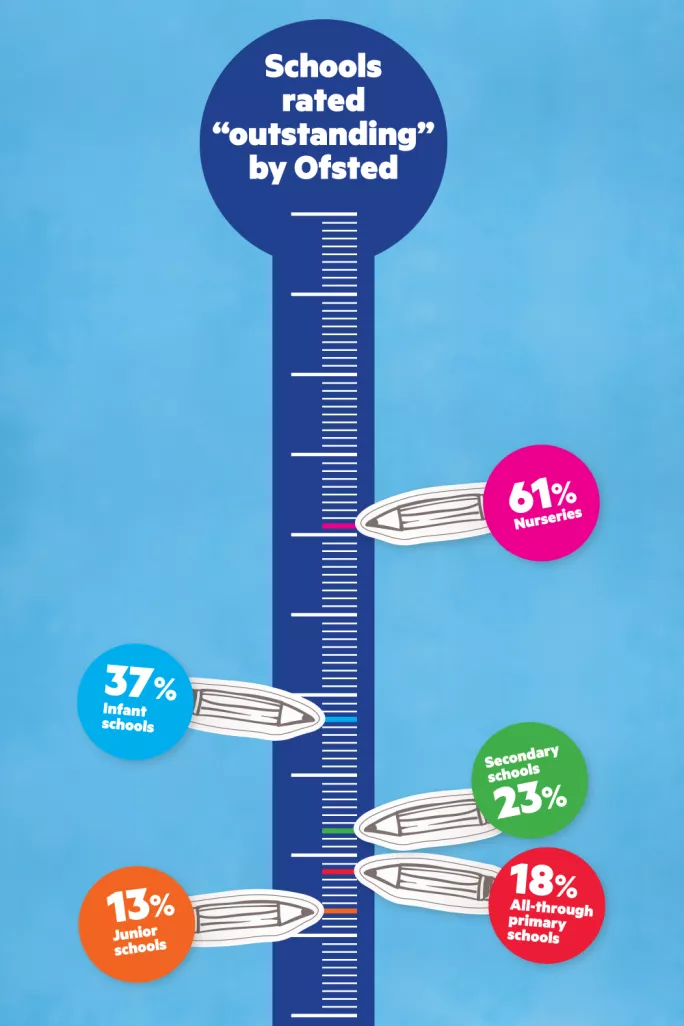Why are junior schools less likely to get a top rating?

Infant schools are almost three times more likely to have received an “outstanding” grade from Ofsted grade than junior schools, a TES analysis shows.
The stark divide in inspection judgements between the two primary phases has raised questions about perverse incentives for schools to inflate or suppress the test results of different age groups.
Some headteachers believe that overly generous teacher assessments for seven-year-olds help infant schools to get better Ofsted grades, at the expense of junior schools who then find it harder to show that pupils have made enough progress.
One junior school head, who wished to remain anonymous, told TES: “As far as Ofsted is concerned, they have been very data-focused in the past, and progress measures, in particular, have been of interest to them…It becomes almost impossible for a junior school to show [the required] level of progress, because of the high level of attainment that children are coming in with.”
‘Unfair’ ratings
Ofsted does not break down primary inspection results into infant, junior and all-through schools. But a TES analysis of the underlying data for Ofsted verdicts up to the end of September showed that 37 per cent of infant schools were judged “outstanding”, compared with just 13 per cent of junior schools.
The proportion of all-through primaries judged “outstanding” was 18 per cent. The figure for junior schools was lower than the figures for nurseries, all-through primaries and secondary schools.
The analysis comes in the week that an Education Policy Institute report suggested that Ofsted ratings may be unfair, because secondaries in the poorest areas are more likely to be declared failing than those serving wealthy communities.
Commenting on the disparity in judgements between junior and infant schools, Pam Sammons, professor of education at the University of Oxford, pointed out that the key stage 1 tests, which play such an important part in infant school Ofsted verdicts, are assessed by classroom teachers.
But she said that reading and maths tests at the end of KS2 were marked externally, with only writing assessed by teachers. She suggested that this could help explain a difference in Ofsted grades. “There is an argument that that is the case, and teacher assessment is not a very reliable indicator,” Professor Sammons said.
‘It’s because of the high level of attainment that children are coming in with’
“There’s always a halo effect with teacher judgement, and they tend to judge to the best of a child’s ability.”
When “good” and “outstanding” Ofsted grades were combined, TES found a 9 percentage point gap between infant and junior schools, with the former on 95 per cent, and the latter on 86 per cent.
All-through primaries again fell between the two figures, with 90 per cent of schools judged at least “good”. Professor Sammons also noted that primary schools that combined infant and junior phases had an incentive to “push down” the grades in KS1, so that their results in KS2 looked better.
Academics from Education Datalab have suggested that it is this phenomenon, rather than the inflation of scores by infant schools, that could be doing the most damage to junior schools. The suppression of KS1 scores in primaries could mean that average progress levels for KS2 pupils are inflated to a point where junior schools cannot compete (see box, below).

‘Unsettling’ transition
Professor Sammons added that research in the 1980s had suggested that the transition from infant to junior school could be unsettling for some children. “Maybe if your child is going to go from an infant to a junior, just watch out to see if there are transition issues that might unsettle them,” she said.
“But it’s not likely to be as important as the general quality of the schools, the general relationship with the other children, and whether the child is happy. Those would be more important concerns for parents.”
Ofsted said that it was aware of the difference in inspection outcomes for infant and junior schools.
“The quality of infant schools in this country is very high and their response to important issues like the need to teach systematic synthetic phonics effectively has been strong,” a spokesman said. “Such work has been reflected in generally high achievement in the KS1 Sats.
“However, just as we have reported on the difficulties we have seen in some schools when pupils transition from primary to secondary school, the transition from infants to juniors can be equally challenging to get right. This can lead to some lag in pupils’ learning when they join KS2 in a new school.”
You need a Tes subscription to read this article
Subscribe now to read this article and get other subscriber-only content:
- Unlimited access to all Tes magazine content
- Exclusive subscriber-only stories
- Award-winning email newsletters
Already a subscriber? Log in
You need a subscription to read this article
Subscribe now to read this article and get other subscriber-only content, including:
- Unlimited access to all Tes magazine content
- Exclusive subscriber-only stories
- Award-winning email newsletters